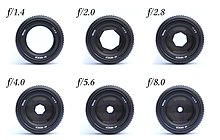Stopping down

Inphotography,stopping downrefers to increasing the numericalf-stopnumber (for example, going fromf/2 tof/4), which decreases the size (diameter) of theapertureof a lens, resulting in reducing the amount of light entering theirisof alens.[1][2]: 112
Reducing the aperture size increases thedepth of fieldof the image. In the case offilmcameras, this allows less light to reach thefilm plane– to achieve the sameexposureafter stopping down, it is necessary to compensate for the reduced light by either increasing the exposure time, or using aphotographic filmwith a higherfilm speed (ISO).In the case ofdigital cameras,stopping down the aperture allows less light to reach theimage sensor– to achieve the same exposure, it is necessary to compensate for the reduced light by either increasing the exposure time, or increasing thesignal gainof the sensor by increasing the camera'sISOsetting. Alternatively, more light can be added to the scene by increasing the amount of light illuminating the scene, such as by using or increasing the strength ofelectronic flashor other light sources.[3]
As a lens is stopped down from its maximum (widest) aperture, most lens aberrations (spherical aberration,comaandastigmatism) are decreased, but lensdiffractionincreases. The effect is that for most lenses, the balance between the decreasing aberrations and the increasing diffraction effects of stopping down the lens means that lenses have an optimum aperture for best results, often about three stops closed down from maximum aperture, so for a lens with a maximum aperture of ƒ/2.8, ƒ/8 would be the optimum aperture.[2]: 180
References
[edit]- ^London, Barbara; Upton, John; Stone, Jim (2013).Photography(Eleventh ed.). Pearson Education Canada.ISBN978-0205933808.
- ^abAllen, Elizabeth (2011).The Manual of Photography(10th ed.). Oxford: Elsevier/Focal Press.ISBN978-0240520377.
- ^Langford, Michael; Bilissi, Efthimia (2010).Langford's Advanced Photography(8th ed.). Oxford: Focal.ISBN978-0240521916.
